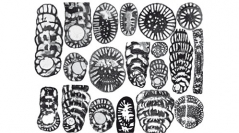

 Geodiversitas
36 (2) - Pages 173-208
Geodiversitas
36 (2) - Pages 173-208Rhapydionina gr. liburnica and its flabelliform variant Fanrhapydionina flabelliformis n. gen., n. sp. are the most outstanding components of a group, part of the Rhapydionininae subfamily, widely expanded in restricted environments of the carbonate platforms in north-occidental Mediterranean area by Campanian--Maastrichtian time. This group, like all Alveolinacea, comprises chambers divided into “primary chamberlets” by radial secondary partitions (“cloisonnettes”) perpendicular to the wall, hollowed out near the septum as to give way to a preseptal undivided volume (“preseptal passage”), crossed only by faint “preseptal buttresses”, and like all Rhapydioninidae a compact fabric in the axial part of chambers (“central endoskeleton”) irregularly crossed by some “secondary chamberlets”. The distinctive features of the group are a marked tendency to “uncoiling” (short involute scroll followed by a large “uniserial rectilinear part”: PRU in the text) and mainly a convex apertural “skull-cap”; the peripheral (“primary”) openings of this apertural riddle, oblique to the chamber axis, apparently isolate, in sections, the central endoskeleton from the rest of the test. The group appears and expands by the end of Cretaceous times. In Greece, two biozones, established on the distribution of members of the Rhapydioninidae family are distinguished: “CsB6”, partly Campanian-Maastrichtian in age, and “CsB7” partly Maastrichtian. The Rhapydionina Stache, 1913 species of the CsB6 biozone, called R. gr. dercourti as a whole, are equipped with small proloculus and keep a relatively large involute scroll. Among them, three new species are identified: R. bulbiformis n. sp. small in size, with a tiny proloculus, is assumed to be close to the origin of the group; R. dercourti n. sp., of medium size, with still a little proloculus, initial scroll relatively large, PRU essentially cylindrical to conical in shape, is well spread; R. fourcadei n. sp. close to the preceding, develops flattened chambers and a larger number of cloisonnettes, forecasting the Fanrhapydionina n. gen. way. Rhapydionina aff. liburnica mainly populates the CsB7 biozone, devoid of the previous species; the populations are close to the Slovene type of the species, specially because of their important uncoiling part, but are equipped with smaller proloculus, hardly larger than those of the CsB6 biozone. Moreover, the CsB7 biozone conceals Fanrhapydionina flabelliformis n. gen., n. sp., structurally identical to R. liburnica (Stache, 1889) but with a larger proloculus and a fan-shaped evolute part in the A generation. A CsB6 less specialized precursor (Fanrhapydionina aff. flabelliformis) proves individuality of this branch.
Adriatico-Aegean carbonate platforms, Greece, biostratigraphy, Campanian-Maastrichtian, new genus, new species.